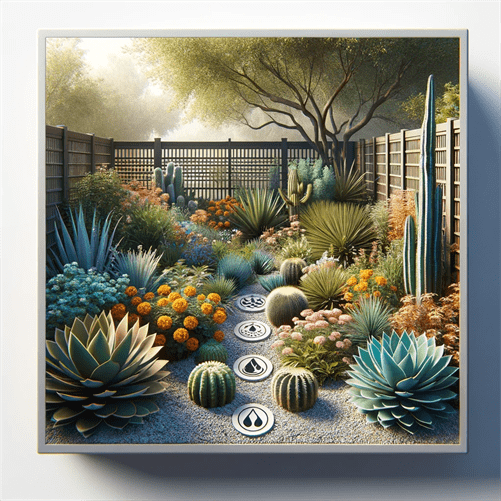In an age where water conservation is not just a choice but a necessity, water-wise gardening has emerged as an essential practice for gardeners across various climates.
Adapting to the challenges of water scarcity, this approach to gardening focuses on innovative techniques and plant choices that thrive in low-water conditions.
This extensive guide delves into the world of water-wise gardening, providing valuable insights into cultivating a flourishing garden that withstands drought while conserving one of Earth’s most precious resources.

Understanding Water-Wise Gardening
Water-wise gardening, often synonymous with xeriscaping, is a method of landscaping that prioritizes water efficiency. It involves choosing plants that are naturally drought-resistant, optimizing irrigation practices, and designing gardens that require minimal water.
This approach is gaining popularity, especially in regions where water scarcity is a growing concern.
1. The Importance of Drought-Resistant Plants
The foundation of water-wise gardening lies in selecting plants that naturally adapt to dry conditions. Drought-resistant plants, often native to arid regions, have evolved to survive with limited water.
Succulents, cacti, and certain perennial grasses are prime examples. These plants typically require less frequent watering and can thrive in harsher, dryer climates.
2. Soil Management for Water Conservation
Soil type plays a pivotal role in water retention and drainage. Understanding and managing your soil can significantly impact your garden’s water efficiency.
Incorporating organic matter into the soil can improve its structure, enhancing water retention in sandy soils and drainage in clay soils.
Additionally, using mulch can reduce surface evaporation and help maintain soil moisture.
3. Efficient Irrigation Techniques
Efficient watering is crucial in water-wise gardening. Drip irrigation systems, which deliver water directly to the plant roots, are highly effective and water-efficient. These systems minimize evaporation and runoff, ensuring that water is used precisely where it’s needed.
Additionally, using timers or smart irrigation controllers can automate the watering process, optimizing water use based on weather conditions and soil moisture levels.
4. Timing and Frequency of Watering
Watering your garden at the right time can significantly reduce water wastage. Early morning watering is typically best, as it minimizes evaporation and allows plants to absorb water more effectively.
Deep, infrequent watering is preferable to shallow, frequent watering. This encourages plants to develop deeper root systems, making them more drought-resistant.
5. Garden Design for Water Efficiency
Designing your garden with water efficiency in mind can make a substantial difference. Grouping plants with similar water needs together, creating windbreaks to reduce evaporation, and choosing permeable materials for paths and patios to increase rainwater infiltration are all effective strategies.
6. Embracing Mulching
Mulching is a highly effective water-wise gardening technique. It involves covering the soil around plants with materials like bark, leaves, or straw to reduce water evaporation.
Mulch also suppresses weeds, which compete with plants for water, and adds organic matter to the soil as it decomposes.
7. Rainwater Harvesting and Storage
Collecting and using rainwater for irrigation is a sustainable aspect of water-wise gardening. Rain barrels or cistern systems can be used to capture rainwater, which can then be used for watering the garden during dryer periods.
This not only conserves water but also reduces reliance on municipal water supplies.
8. Reducing Lawn Areas
Traditional lawns are often high water-use areas. In water-wise gardening, reducing lawn space or replacing conventional grass with drought-tolerant alternatives can significantly cut down on water usage.
Consider using native grasses, ground covers, or creating rock gardens as alternatives.
9. Regular Garden Maintenance
Routine maintenance, such as weeding, pruning, and deadheading, can improve the overall health and water efficiency of your garden.
Healthy plants are typically more resilient to drought and can make better use of the water they receive.
10. Staying Informed and Adaptable
The field of water-wise gardening is continually evolving. Staying informed about the latest techniques, plant varieties, and technological advancements is crucial.
Being adaptable and willing to adjust your gardening practices as you learn and as conditions change is key to successful water-wise gardening.
Fostering Resilience in Your Garden
Water-wise gardening is about creating a garden that is not only beautiful and productive but also resilient and sustainable. By employing the strategies outlined in this guide, you can develop a garden that thrives in dry conditions and contributes positively to water conservation efforts.
Embrace the principles of water-wise gardening and transform your garden into a model of efficiency and sustainability, a true oasis in any climate.














